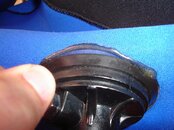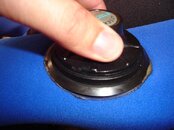Tiro_Afila
Guest
I have just received my dry suit from a seller on ebay. The suit itself is in great condition, but has not been used for several years, and the valve seals need a little help. This is my first dry suit, and I am not sure what kinds of repair I need. I have attached some pictures of the valves, and I am wondering if anyone can tell me what I need. Can I have the valves re-sealed, or do they need to be replaced. The inflation valve does not stick at all, but both the inflation valve and the exaust valve look as thought the seal may need some care.










